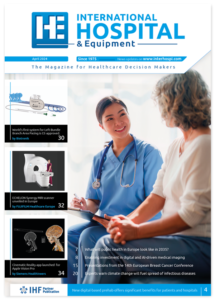Siemens Healthineers and Braunschweig Municipal Hospital enter into strategic technology partnership
Braunschweig Municipal Hospital and Siemens Healthineers are breaking new ground through an innovative medical technology partnership. Together, they have entered into a long-term Asset Management Services (AMS) contract. Braunschweig Municipal Hospital is one of the largest hospitals in northern Germany, with 1,499 beds and 38 clinics and institutes. Siemens Healthineers will assume responsibility for supplying and maintaining all initial and replacement equipment in the areas of radiology, radiotherapy and nuclear medicine. The partnership also includes strategic and operational consulting services to drive continuous improvement initiatives over time. On October 23, in Braunschweig, the parties signed a ten-year contract with a five-year extension option.
“The primary goal of this technology partnership is to assure high-quality and cost-effective medical care for our patients through first-class diagnostic radiological, surgical and radiotherapy services”, explains Ulrich Markurth, mayor of Braunschweig and chairman of the hospital’s supervisory board.
“We are very pleased to be able to contribute as a technology partner in the coming years to further improve the quality of patient care at the Braunschweig Municipal Hospital and its performance capability,” says Dr. Stefan Schaller, head of Siemens Healthineers in Germany. “In addition to the provision of innovative medical technology systems, we support the Braunschweig Municipal Hospital in planning new buildings and optimizing workflows in radiology, cardiology and the emergency department as well as in all steps towards the digitization of healthcare. This holistic package provides the hospital with security of planning, budget certainty and future reliability over the entire duration of the project.”
Matthias Platsch, President of Siemens Healthineers Services adds: “We are delighted to have been chosen as a technology partner for the Braunschweig Municipal Hospital and we are both proud and humbled by the vote of confidence that this important healthcare provider has placed in our new services portfolio. In this, Siemens Healthineers’ first asset management services partnership in Germany, we will combine the strength of our innovative product portfolio with the forward-looking business approach of our enterprise services to help deliver best-value clinical outcomes for patients. Together with the Braunschweig Municipal Hospital, we will transform healthcare delivery by leveraging our combined expertise in established and new care models. With a fresh look at the design and operation of the facility we will significantly improve the patient experience, and the new technologies we will deploy will enable more efficient and more precise clinical diagnosis. We are very excited to play such a role in the future of healthcare in Braunschweig.”
Hospital CEO Dr. Andreas Goepfert explains that the award of the contract for this technology partnership, including the vendor-neutral procurement and management of around 50 new systems (ranging from magnetic resonance and computed tomography, to angiography, X-ray, nuclear medicine and radiotherapy machines) is the result of a Europe-wide call for tenders via an initial selection process and a competitive dialogue. The fundamental premise is that this innovative, end-to-end partnership model – for procurement and management, in particular – will generate savings for the hospital compared to a series of individual, reactive calls for tender.
As a consequence, Siemens Healthineers will be responsible for procurement, installation, maintenance, servicing, an innovation guarantee (through updates and upgrades), and an availability guarantee for all devices. The long-term technology roadmap takes into consideration the hospital’s strategic orientation, especially its current plan to concentrate the hospital at two locations. A Syngo.via Enterprise solution will also give the hospital access to all Siemens Healthineers’ software applications, enabling it to stay at the forefront of digital innovation.
“The technology partnership in the area of radiology will bring together the heterogeneous imaging device landscape and IT in our radiology department at Braunschweig Municipal Hospital,” forecasts its medical director, Dr. Thomas Bartkiewicz. “That ensures we always stay at the forefront of innovation in diagnostic imaging and imaging-based treatment, while ensuring radiation exposure for patients and employees is kept to a minimum.” Complex interfaces will be removed and the clinical staff will find their day-to-day work routines become noticeably simpler. Nursing director Ulrich Heller adds: “Different operating processes from various device manufacturers will be reduced to a single standardized system.” This will speed up workflows and improve quality of care at the same time. In addition, maintenance plans and contracts that were not previously coordinated will be combined as part of an optimized programme in the future. The result will be a sustainable reduction in maintenance costs.
The ‘Braunschweig Model’ for a technology partnership enables the hospital to respond flexibly to changing requirements and future device needs due to a separate ‘innovation budget’. This includes possible changes in both the scope and the timing of procurement throughout the entire term of the partnership. The fixed quarterly payment fee also provides the hospital with budgetary certainty for the contract duration.
“The technology partnership guarantees predictability of costs whilst providing security of investments in the fields of radiology, radiotherapy and nuclear medicine,” says hospital CEO Goepfert. The long-term technology partnership will enable the hospital to benefit from future technological advances in radiology, including innovative algorithms to improve image reading and computer-assisted diagnostic modules. This will ensure high-quality and cost-effective patient care for the long term.
The AMS also encompasses a number of flagship projects in which the two partners will work closely together in the future. For example, Siemens Healthineers will contribute the know-how in the area of molecular diagnostics built up by its company NEO New Oncology GmbH. Thanks to genome analyses of tumour tissue performed by NEO New Oncology, Braunschweig Municipal Hospital will be able to create customized, targeted treatment recommendations that will facilitate highly promising precision medical treatment for cancer patients.
www.siemens.com/healthineers

